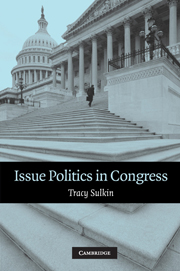Book contents
- Frontmatter
- Contents
- List of Figures
- List of Tables
- Acknowledgments
- Issue Politics in Congress
- 1 Electoral Challenges and Legislative Responsiveness
- 2 A Theory of Issue Uptake
- 3 The Nature of Campaign and Legislative Agendas
- 4 Assessing Uptake
- 5 Who Responds? Explaining Individual Variation in Uptake
- 6 Patterns of Responsiveness in Congress
- 7 The Electoral Impacts of Uptake
- 8 Uptake and Public Policy
- 9 Elections, Governance, and Representation
- Appendix: House and Senate Samples
- References
- Index
9 - Elections, Governance, and Representation
Published online by Cambridge University Press: 08 January 2010
- Frontmatter
- Contents
- List of Figures
- List of Tables
- Acknowledgments
- Issue Politics in Congress
- 1 Electoral Challenges and Legislative Responsiveness
- 2 A Theory of Issue Uptake
- 3 The Nature of Campaign and Legislative Agendas
- 4 Assessing Uptake
- 5 Who Responds? Explaining Individual Variation in Uptake
- 6 Patterns of Responsiveness in Congress
- 7 The Electoral Impacts of Uptake
- 8 Uptake and Public Policy
- 9 Elections, Governance, and Representation
- Appendix: House and Senate Samples
- References
- Index
Summary
The dual nature of Congress has long been one of its defining features. Because it functions both as a policymaking body and as a representative body, legislators must successfully balance the substantive tasks of making law with the more symbolic tasks of cultivating good relationships with their constituents in their districts or states (Davidson and Oleszek 1996). Moreover, the reelection imperative requires that they regularly persuade constituents, potential challengers, and other political actors of their accomplishments in each of these arenas by organizing and running successful campaigns. Thus, as Fenno reminds us, representatives and senators spend their careers “moving between two contexts, Washington and home, and between two activities, governing and campaigning” (1989, 119).
This duality is reflected in research on legislative studies, with the continued development of theoretically rich and methodologically rigorous literatures on these two contexts and two activities. By and large, however, these literatures have been separate, with studies focusing on legislators' activities in Washington or their behavior as candidates on the campaign trail or their home styles in their constituencies. What is missing is a similarly nuanced literature on the linkages between the two contexts and two activities. For example, little attention has been paid to how legislators' experiences as candidates shape their behavior as policymakers, an omission that is particularly surprising when we consider that electoral connection theories are central to our understanding of the motivations underlying legislative behavior.
- Type
- Chapter
- Information
- Issue Politics in Congress , pp. 167 - 178Publisher: Cambridge University PressPrint publication year: 2005



